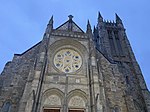Taftville, Connecticut

Taftville is a small village in eastern Connecticut. It is a neighborhood of Norwich but has its own post office (ZIP Code 06380). It was established in 1866 as site for the large Taftville Mill, later Ponemah Mill. The village is listed on the National Register of Historic Places as Taftville and as alternative name Taftville/Ponemah Mill National Register Historic District. Currently redevelopment of the large mill is being conducted by The O'Neill Group in conjunction with OneKey LLC. The National Park Service will oversee the historic preservation of the structure, to ensure the historic elements are sustained. The 430,000-square-foot (40,000 m2) Ponemah Mill is being converted into luxury apartments and commercial space.
Excerpt from the Wikipedia article Taftville, Connecticut (License: CC BY-SA 3.0, Authors, Images).Taftville, Connecticut
South B Street, Norwich
Geographical coordinates (GPS) Address Nearby Places Show on map
Geographical coordinates (GPS)
| Latitude | Longitude |
|---|---|
| N 41.567777777778 ° | E -72.049166666667 ° |
Address
South B Street 9
06380 Norwich
Connecticut, United States
Open on Google Maps










